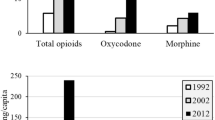Intramuscular administration of the central analgesics fentanyl and Analgin (dipyrone) along with the pain mediators cholecystokinin (CCK), glutamate, ATP, and adrenaline, and the analgesia mediator adenosine, which have weak penetration into the CNS, induced maximal analgesic effects at minimally effective doses in the tailflick test in rats. The minimal effective doses of Analgin and fentanyl decreased by factors of 50–220 in response to combined i.m. administration of each of the analgesics with CCK, glutamate, ATP, adrenaline, and adenosine at subthreshold does which were ineffective when given alone. Intragastric administration of lidocaine and subdiaphragmatic gastric vagotomy completely blocked the analgesic effects of these combinations. These data lead to the conclusion that peripherally acting pain and analgesia mediators given systemically potentiate the central analgesic actions of Analgin and fentanyl via stimulation of the chemoreceptors of vagal afferents in the gastric mucosa.
Similar content being viewed by others
References
S. E. Serdyuk and V. E. Gmiro, “Involvement of gastric efferents in the reflex mechanisms of urgent adaptation to stressors,” Ros. Fiziol. Zh., 81, No. 9, 40–51 (1995).
S. E. Serdyuk and V. E. Gmiro, “Analgesic and antidepressant actions of adrenaline stress in endogenous activation of the afferent systems of the stomach in rats,” Ros. Fiziol. Zh., 83, No. 8, 111–120 (1997).
B. Bannwarth, F. A. Allaert, B. Avouac, et al., “A randomized, double-blind, placebo controlled triphosphate in study of oral adenosine subacute low back pain,” J. Rheumatol., 32, No. 6, 1114–1117 (2005).
D. L. DeHaven-Hudkins, L. C. Burgos, J. A. Cassel, et al., “Loperamide (ADL 2-1294), an opioid antihyperalgesic agent with peripheral selectivity,” J. Pharmacol. Exp. Ther., 289, No. 1, 494–502 (1999).
S. G. Hamilton and S. B. McMahon, “ATP as a peripheral mediator of pain,” J. Auton. Nerv. Syst., 81, No. 1–3, 187–194 (2000).
D. H. Lee, X. Liu, H. T. Kim, et al., “Receptor subtype mediating the adrenergic sensitivity of pain behavior and ectopic discharges in neuropathic Lewis rats,” J. Neurophysiol., 81, No. 5, 2226–2233 (1999).
M. E. Lynch, A. J. Clark, and J. Sawynok, “Intravenous adenosine alleviates neuropathic pain: a double blind placebo controlled crossover trial using an enriched enrolment design,” Pain, 103, No. 1–2, 111–117 (2003).
A. H. Meng,Y. L. Ling, X. P. Chang, and J. L. Zhang, “Anti-inflammatory effect of cholecystokinin and its signal transduction mechanism in endotoxic shock rat,” World. J. Gastroenterol., 8, No. 4, 712–717 (2002).
K. Omote, T. Kawamata, M. Kawamata, and A. Maniki, “Formalininduced release of excitatory amino acids in the skin the rat hindpaw,” Brain Res., 787, No. 1, 161–164 (1998).
J. Sawynok, “Topical and peripherally acting analgesics,” Pharmacol. Rev., 55, No. 1, 1–20 (2003).
J. Sawynok and A. Reid, “Peripheral adenosine 5’-triphosphate enhances nociception in the formalin test via activation of a purinergic p2X receptor,” Eur. J. Pharmacol., 330, No. 2–3, 115–121 (1997).
K. F. Sjölund, M. Segerdahl, and A. Sollevi, “Adenosine reduces secondary hyperalgesia in two human models of cutaneous inflammatory pain,” Anesth. Analg., 88, No. 3, 605–610 (1999).
R. A. Tasker, B. J. Connell, and M. J. Yole, “Systemic injections of alpha-1 adrenergic agonists produce antinociception in the formalin test,” Pain, 49, No. 3, 383–391 (1992).
J. E. Torres-Lopes, I. E. Juarez-Rojop, V. Granados-Soto, et al., “Peripheral participation of cholecystokinin in the morphineinduced peripheral antinociceptive effect in non-diabetic and diabetic rats,” Neuropharmacology, 52, No. 3, 788–795 (2007).
J. T. van Crugten, A. A. Somogyi, R. L. Nation, and G. Reynolds, “Concentration-effect relationships of morphine and morphine-6 beta-glucuronide in the rat,” Clin. Exp. Pharmacol. Physiol., 24, No. 5, 359–364 (1997).
Author information
Authors and Affiliations
Corresponding author
Additional information
Translated from Rossiiskii Fiziologicheskii Zhurnal imeni I. M. Sechenova, Vol. 98, No. 3, pp. 325–330, March, 2012.
Rights and permissions
About this article
Cite this article
Serdyuk, S.E., Gmiro, V.E. Peripherally Acting Mediators of Pain and Analgesia Potentiate the Central Analgesic Effects of Fentanyl and Analgin (Dipyrone) in Rats. Neurosci Behav Physi 43, 1028–1031 (2013). https://doi.org/10.1007/s11055-013-9846-5
Received:
Published:
Issue Date:
DOI: https://doi.org/10.1007/s11055-013-9846-5




